- Abstract
- Among summer and autumn tomatoes, harvest volume of tomatoes for processing (main data).
- Harvest volume of summer/autumn tomatoes for processing (by prefecture).
- Among summer and autumn tomatoes, the area planted with tomatoes for processing (main data).
- Among summer/autumn tomatoes, the area planted with tomatoes for processing (by prefecture).
- The amount of processed tomatoes shipped among summer and autumn tomatoes.
- Reference
Abstract
Looking at the trends and characteristics of summer/autumn tomatoes, which are particularly noteworthy among fruit vegetables in Japanese agriculture, from 2022 data, the harvest yield was the highest in the country at 24.7kt, the cultivated area was the largest in the country at 435ha, and the shipping volume was highest in Ibaraki at 10.9kt. This indicates that summer/autumn tomato production in Japan has reached a certain scale. Additionally, since Ibaraki is a region that stands out in terms of shipping volume, it is possible that production there is particularly active. On the other hand, summer/autumn tomatoes are widely produced across the country, and it appears that they are grown in a variety of regions. In this way, Japanese summer/autumn tomato agriculture is characterized by the fact that while it maintains a stable production scale, there are differences in regional characteristics and production volumes.
Among summer and autumn tomatoes, harvest volume of tomatoes for processing (main data).
When examining data from 1989 to 2022 on the harvest volume of summer/autumn tomatoes for processing in Japanese agriculture, the national peak harvest was a record 85.6 kt in 1989, but has since shown a declining trend. The 2022 harvest is down to 28.9% of its peak. This suggests that there has been a change in the demand for and production of tomatoes for processing. For example, this may be due to changes in demand, a shift to other substitutes, or advances in production technology. The decline in demand for tomatoes for processing may be due to changes in consumer eating habits and the diversification of processed foods. Additionally, agricultural policies and international market influences are factors to consider. Thus, the declining trend in processing tomato yields appears to be due to a combination of various economic, social and technological factors.
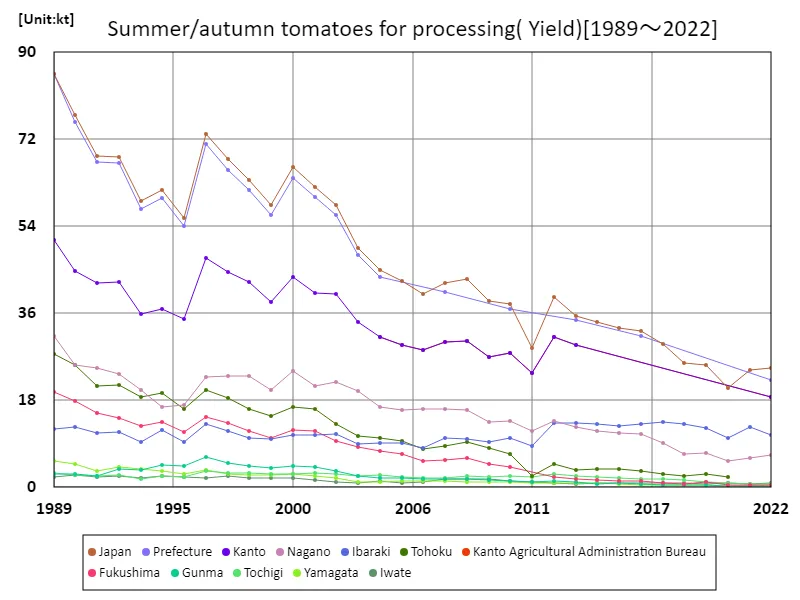

The maximum is 85.6kt[1989] of Japan, and the current value is about 28.9%
Harvest volume of summer/autumn tomatoes for processing (by prefecture).
Looking at data for 2022 regarding fruit vegetable harvests in Japanese agriculture, Ibaraki recorded the highest yield overall at 10.9kt, which is currently the highest value. This suggests that Ibaraki is a major region for fruit and vegetable production. One reason for this is that Ibaraki’s agriculture is favorable due to the region’s favorable climate and soil conditions, which are ideal for growing fruit and vegetables. A general characteristic of fruit and vegetable production in Japan is that each region produces its own produce, each with its own distinctive characteristics. Additionally, production volumes may vary depending on the weather and season. For example, in the southern region, the warm climate allows cultivation even in winter, so stable harvests can be expected throughout the year, whereas in the northern region, greenhouse cultivation is required depending on the season, and production volume tends to fluctuate. Additionally, advances in agricultural technology and changes in agricultural policies also affect fruit and vegetable yields. While the introduction of new cultivation techniques and facilities has improved yields, it has also given rise to challenges such as competition from imports and labor shortages. These factors affect fruit and vegetable production, leading to fluctuations in yields from region to region and from year to year.
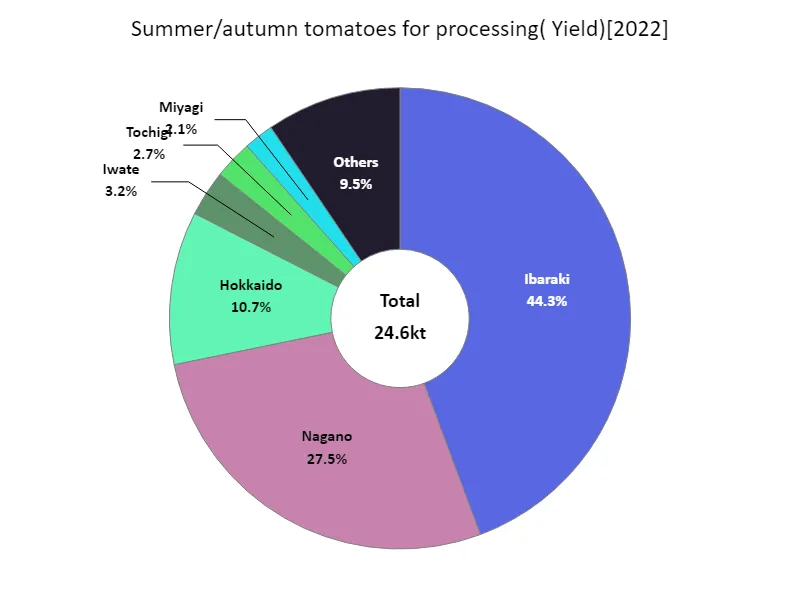

The maximum is 10.9kt of Ibaraki, the average is 1.37kt, and the total is 24.6kt
Among summer and autumn tomatoes, the area planted with tomatoes for processing (main data).
When examining data from 1989 to 2022 on the area of land planted to summer/autumn processing tomatoes in Japanese agriculture, the national peak was a record 1.28 kha in 1989, but a downward trend has been observed since then. The current area under cultivation is down to 34% of its peak. This suggests that there has been a change in the demand for and production of tomatoes for processing. For example, this could be due to changes in demand, a shift to other substitutes, or improvements in agricultural technology. The decrease in the area planted to tomatoes for processing may also be due to structural changes in agriculture and economic conditions. As agriculture modernizes and urbanizes, the reduction in farmland and the number of people working in agriculture may be affecting the area planted with tomatoes for processing. Additionally, market factors such as demand stability and price fluctuations are important in the production of tomatoes for processing. Thus, the declining trend in the area planted to tomatoes for processing can be attributed to a combination of various economic, social and technological factors. In the future, it will be necessary to promote sustainable agricultural production while responding flexibly to changes in demand and market conditions.
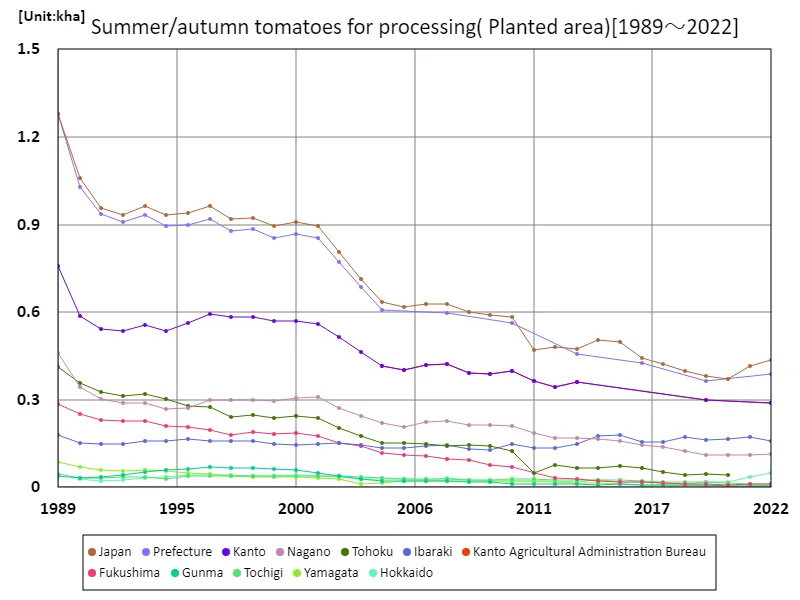

The maximum is 1.28kha[1989] of Japan, and the current value is about 34%
Among summer/autumn tomatoes, the area planted with tomatoes for processing (by prefecture).
Looking at data for 2022 regarding the area of fruit and vegetable cultivation in Japanese agriculture, Ibaraki recorded the largest area overall at 160 hectares, which is currently the maximum value. It appears that Ibaraki is a major region in terms of the area cultivated with fruit vegetables. One reason for this is that Ibaraki’s agriculture is favorable due to the region’s favorable climate and soil conditions, which are ideal for growing fruit and vegetables. A general characteristic of fruit vegetables is that they are grown in every region of Japan, with each region having its own distinctive cultivated area. In particular, in warmer regions, cultivation is possible throughout the year and they tend to be cultivated over larger areas. On the other hand, in colder regions, greenhouse cultivation is the norm depending on the season and climate, and the area may be relatively small. Advances in agricultural technology and changes in agricultural policies are also affecting the area planted to fruit vegetables. While the introduction of new cultivation techniques and facilities has made it possible to expand the area of land under cultivation, it has also given rise to challenges such as competition from imports and labor shortages. As such, the area cultivated with fruit vegetables varies depending on the region and season, with regional characteristics, technological advances, market conditions, and other factors influencing the cultivated area. In the future, it will be necessary to promote sustainable agricultural production while taking into account changes in demand and environmental considerations.
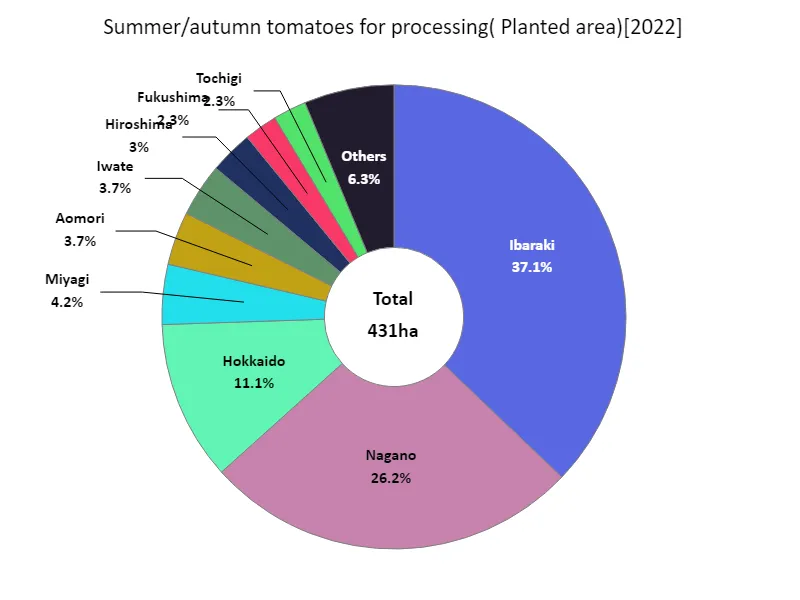

The maximum is 160ha of Ibaraki, the average is 23.9ha, and the total is 431ha
The amount of processed tomatoes shipped among summer and autumn tomatoes.
Looking at data for 2022 on the shipment volume of summer and autumn processing tomatoes in Japanese agriculture, Ibaraki recorded the highest overall shipment volume of 10.9 kt, with the average being 1.36 kt. Total shipments were 24.5kt, made up of production in multiple regions, including Ibaraki. It is worth noting that Ibaraki is a major producer of tomatoes for processing. Ibaraki has favorable climate and soil conditions and is known as an area suitable for producing tomatoes for processing. Therefore, it is only natural that Ibaraki has the largest overall shipping volume. A general trend is that the shipping volume of tomatoes for processing across Japan has remained at a steady level. This is thought to be due to stable demand and improvements in production technology in each region. Additionally, shipping volumes of tomatoes for processing tend to fluctuate depending on the season. Shipping volumes generally increase during peak harvest periods from summer to autumn, and tend to decrease in winter. This is thought to be due to the limited season suitable for growing tomatoes and fluctuations in demand. In general, production of tomatoes for processing is thriving in several regions, including Ibaraki, and a certain level of shipping volume is maintained throughout Japan.
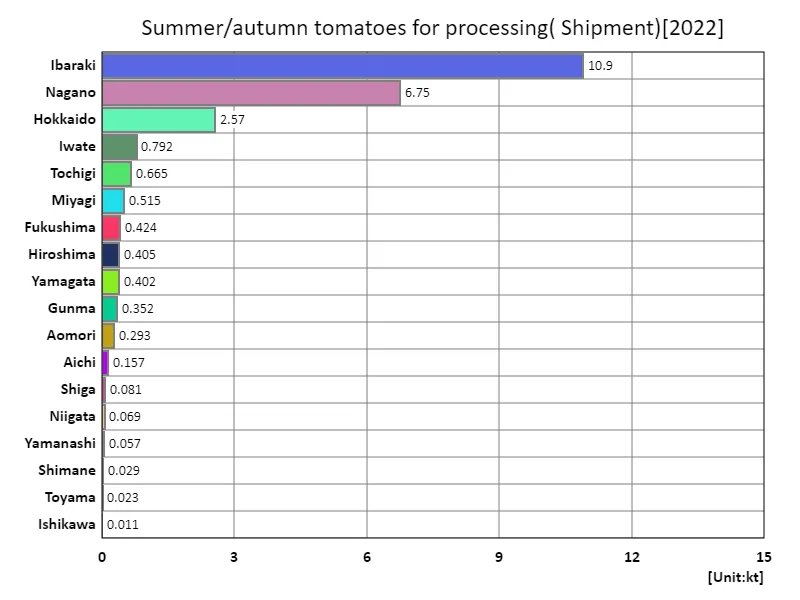

The maximum is 10.9kt of Ibaraki, the average is 1.36kt, and the total is 24.5kt
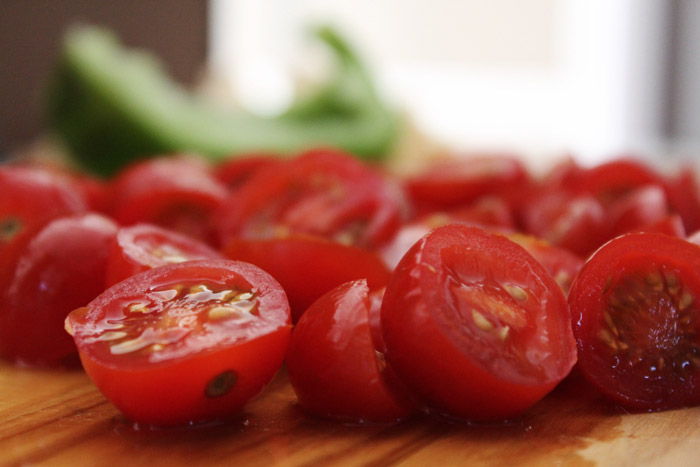


Comments